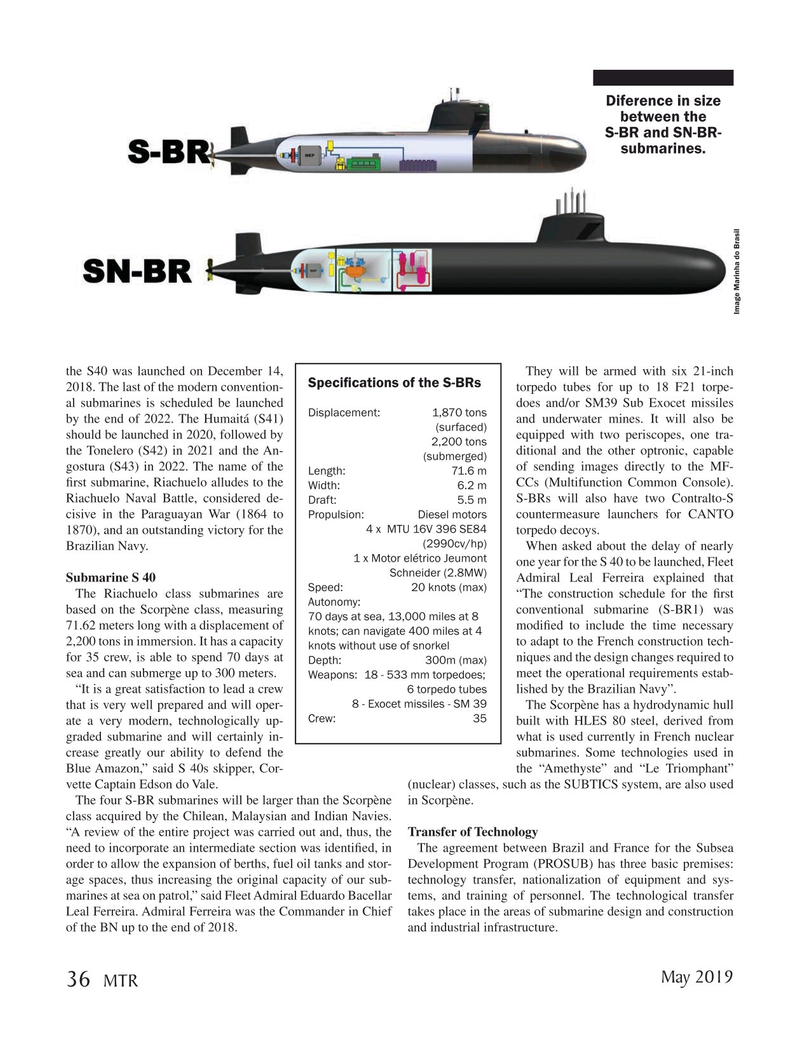
Page 36: of Marine Technology Magazine (May 2019)
Underwater Defense Technology
Read this page in Pdf, Flash or Html5 edition of May 2019 Marine Technology Magazine
Diference in size between the
S-BR and SN-BR- submarines.
Image Marinha do Brasil the S40 was launched on December 14, They will be armed with six 21-inch
Speci? cations of the S-BRs 2018. The last of the modern convention- torpedo tubes for up to 18 F21 torpe- al submarines is scheduled be launched does and/or SM39 Sub Exocet missiles
Displacement: 1,870 tons by the end of 2022. The Humaitá (S41) and underwater mines. It will also be (surfaced) should be launched in 2020, followed by equipped with two periscopes, one tra- 2,200 tons the Tonelero (S42) in 2021 and the An- ditional and the other optronic, capable (submerged) gostura (S43) in 2022. The name of the of sending images directly to the MF-
Length: 71.6 m ? rst submarine, Riachuelo alludes to the CCs (Multifunction Common Console).
Width: 6.2 m
Riachuelo Naval Battle, considered de- S-BRs will also have two Contralto-S
Draft: 5.5 m cisive in the Paraguayan War (1864 to countermeasure launchers for CANTO
Propulsion: Diesel motors 4 x MTU 16V 396 SE84 1870), and an outstanding victory for the torpedo decoys.
(2990cv/hp)
Brazilian Navy. When asked about the delay of nearly 1 x Motor elétrico Jeumont one year for the S 40 to be launched, Fleet Schneider (2.8MW)
Submarine S 40 Admiral Leal Ferreira explained that
Speed: 20 knots (max)
The Riachuelo class submarines are “The construction schedule for the ? rst
Autonomy: based on the Scorpène class, measuring conventional submarine (S-BR1) was 70 days at sea, 13,000 miles at 8 71.62 meters long with a displacement of modi? ed to include the time necessary knots; can navigate 400 miles at 4 2,200 tons in immersion. It has a capacity to adapt to the French construction tech- knots without use of snorkel for 35 crew, is able to spend 70 days at niques and the design changes required to
Depth: 300m (max) sea and can submerge up to 300 meters. meet the operational requirements estab-
Weapons: 18 - 533 mm torpedoes; “It is a great satisfaction to lead a crew lished by the Brazilian Navy”. 6 torpedo tubes 8 - Exocet missiles - SM 39 that is very well prepared and will oper- The Scorpène has a hydrodynamic hull
Crew: 35 ate a very modern, technologically up- built with HLES 80 steel, derived from graded submarine and will certainly in- what is used currently in French nuclear crease greatly our ability to defend the submarines. Some technologies used in
Blue Amazon,” said S 40s skipper, Cor- the “Amethyste” and “Le Triomphant” vette Captain Edson do Vale. (nuclear) classes, such as the SUBTICS system, are also used
The four S-BR submarines will be larger than the Scorpène in Scorpène.
class acquired by the Chilean, Malaysian and Indian Navies. “A review of the entire project was carried out and, thus, the Transfer of Technology need to incorporate an intermediate section was identi? ed, in The agreement between Brazil and France for the Subsea order to allow the expansion of berths, fuel oil tanks and stor- Development Program (PROSUB) has three basic premises: age spaces, thus increasing the original capacity of our sub- technology transfer, nationalization of equipment and sys- marines at sea on patrol,” said Fleet Admiral Eduardo Bacellar tems, and training of personnel. The technological transfer
Leal Ferreira. Admiral Ferreira was the Commander in Chief takes place in the areas of submarine design and construction of the BN up to the end of 2018. and industrial infrastructure.
May 2019 36
MTR
MTR #4 (34-49).indd 36 4/25/2019 9:54:15 AM

 35
35

 37
37
